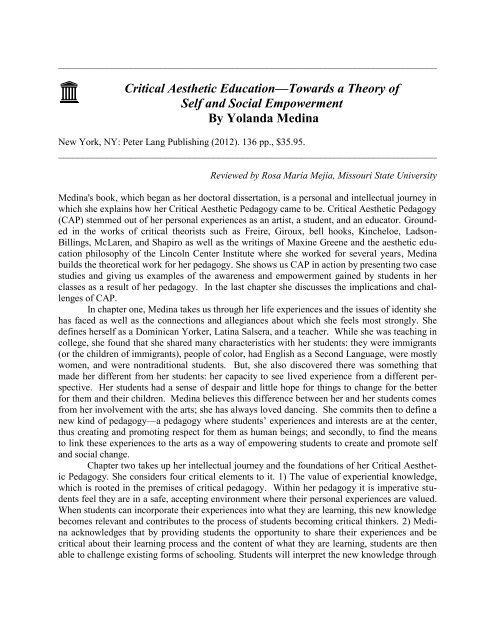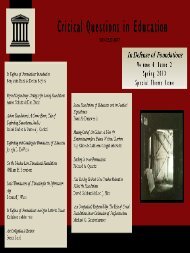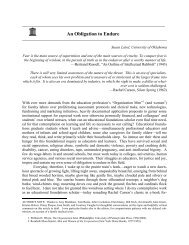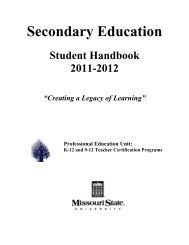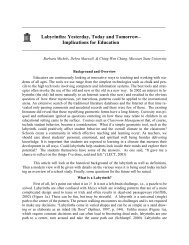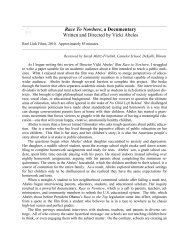Critical Aesthetic Education—Towards a Theory of Self and Social ...
Critical Aesthetic Education—Towards a Theory of Self and Social ...
Critical Aesthetic Education—Towards a Theory of Self and Social ...
You also want an ePaper? Increase the reach of your titles
YUMPU automatically turns print PDFs into web optimized ePapers that Google loves.
______________________________________________________________________________<br />
<strong>Critical</strong> <strong>Aesthetic</strong> <strong>Education—Towards</strong> a <strong>Theory</strong> <strong>of</strong><br />
<strong>Self</strong> <strong>and</strong> <strong>Social</strong> Empowerment<br />
By Yol<strong>and</strong>a Medina<br />
New York, NY: Peter Lang Publishing (2012). 136 pp., $35.95.<br />
______________________________________________________________________________<br />
Reviewed by Rosa María Mejía, Missouri State University<br />
Medina's book, which began as her doctoral dissertation, is a personal <strong>and</strong> intellectual journey in<br />
which she explains how her <strong>Critical</strong> <strong>Aesthetic</strong> Pedagogy came to be. <strong>Critical</strong> <strong>Aesthetic</strong> Pedagogy<br />
(CAP) stemmed out <strong>of</strong> her personal experiences as an artist, a student, <strong>and</strong> an educator. Grounded<br />
in the works <strong>of</strong> critical theorists such as Freire, Giroux, bell hooks, Kincheloe, Ladson-<br />
Billings, McLaren, <strong>and</strong> Shapiro as well as the writings <strong>of</strong> Maxine Greene <strong>and</strong> the aesthetic education<br />
philosophy <strong>of</strong> the Lincoln Center Institute where she worked for several years, Medina<br />
builds the theoretical work for her pedagogy. She shows us CAP in action by presenting two case<br />
studies <strong>and</strong> giving us examples <strong>of</strong> the awareness <strong>and</strong> empowerment gained by students in her<br />
classes as a result <strong>of</strong> her pedagogy. In the last chapter she discusses the implications <strong>and</strong> challenges<br />
<strong>of</strong> CAP.<br />
In chapter one, Medina takes us through her life experiences <strong>and</strong> the issues <strong>of</strong> identity she<br />
has faced as well as the connections <strong>and</strong> allegiances about which she feels most strongly. She<br />
defines herself as a Dominican Yorker, Latina Salsera, <strong>and</strong> a teacher. While she was teaching in<br />
college, she found that she shared many characteristics with her students: they were immigrants<br />
(or the children <strong>of</strong> immigrants), people <strong>of</strong> color, had English as a Second Language, were mostly<br />
women, <strong>and</strong> were nontraditional students. But, she also discovered there was something that<br />
made her different from her students: her capacity to see lived experience from a different perspective.<br />
Her students had a sense <strong>of</strong> despair <strong>and</strong> little hope for things to change for the better<br />
for them <strong>and</strong> their children. Medina believes this difference between her <strong>and</strong> her students comes<br />
from her involvement with the arts; she has always loved dancing. She commits then to define a<br />
new kind <strong>of</strong> pedagogy—a pedagogy where students’ experiences <strong>and</strong> interests are at the center,<br />
thus creating <strong>and</strong> promoting respect for them as human beings; <strong>and</strong> secondly, to find the means<br />
to link these experiences to the arts as a way <strong>of</strong> empowering students to create <strong>and</strong> promote self<br />
<strong>and</strong> social change.<br />
Chapter two takes up her intellectual journey <strong>and</strong> the foundations <strong>of</strong> her <strong>Critical</strong> <strong>Aesthetic</strong><br />
Pedagogy. She considers four critical elements to it. 1) The value <strong>of</strong> experiential knowledge,<br />
which is rooted in the premises <strong>of</strong> critical pedagogy. Within her pedagogy it is imperative students<br />
feel they are in a safe, accepting environment where their personal experiences are valued.<br />
When students can incorporate their experiences into what they are learning, this new knowledge<br />
becomes relevant <strong>and</strong> contributes to the process <strong>of</strong> students becoming critical thinkers. 2) Medina<br />
acknowledges that by providing students the opportunity to share their experiences <strong>and</strong> be<br />
critical about their learning process <strong>and</strong> the content <strong>of</strong> what they are learning, students are then<br />
able to challenge existing forms <strong>of</strong> schooling. Students will interpret the new knowledge through
<strong>Critical</strong> Questions in Education Volume 4:1 53<br />
their own lenses, i.e. coming from their own language <strong>and</strong> cultural background, their social class<br />
<strong>and</strong> gender.<br />
However, in order for this personal interpretation to take place, students 3) need to explore<br />
their own identities <strong>and</strong> allegiances or connections to the different aspects <strong>of</strong> their identities.<br />
Students need to learn what exerts an influence on them <strong>and</strong> how their thoughts might be<br />
shaped by different ideologies. It is important students become aware <strong>of</strong> their biases <strong>and</strong> find<br />
their own voices. When students have a critical awareness <strong>of</strong> their own identities, they are ready<br />
to start a social transformation. 4) To explore students’ identities, Medina uses the aesthetic experience;<br />
this is the added new element to the critical pedagogy premises she has been working<br />
on. She contends that the soma (body) carries memories <strong>and</strong> brings subjective perspectives <strong>of</strong><br />
our feelings <strong>and</strong> views. In her CAP she reinforces the importance <strong>of</strong> the “body authority” which<br />
bridges feelings <strong>of</strong> disempowerment <strong>and</strong> a hopeful imagination that is the source <strong>of</strong> self <strong>and</strong> social<br />
change. She bases her CAP on two defining concepts: “a) Imagination illuminates the path<br />
toward possibilities,” <strong>and</strong> “b) Compassion gives us the desire to embark on the path toward<br />
change.”<br />
Medina shows us in Chapter 3 how CAP can be put into action. She describes two different<br />
case studies she conducted at two different institutions. For these two case studies, she<br />
carefully chose art pieces that would allow students to have shared experiences <strong>and</strong> enable them<br />
to recognize forms <strong>of</strong> oppression. She also carefully selected a set <strong>of</strong> readings to accompany the<br />
art piece for each group <strong>and</strong> that would help create in students an awareness <strong>of</strong> social justice <strong>and</strong><br />
a sense <strong>of</strong> empowerment to promote this change.<br />
One study was at Queen’s College with two different groups <strong>of</strong> undergraduates who<br />
came from under privileged backgrounds. For this case study, she based the artistic experience<br />
on the documentary drama Twilight: Los Angeles by Anna Deavere. She developed a line <strong>of</strong> inquiry,<br />
i.e. the connection between the artwork, the assigned readings, <strong>and</strong> the course content.<br />
She prepared six specific activities related to drama. For this particular piece, students explored<br />
issues <strong>of</strong> race, gender, social class, privilege <strong>and</strong> discrimination, <strong>and</strong> ability. Students had to<br />
write a narrative at the end <strong>of</strong> the semester reflecting on the readings <strong>and</strong> content <strong>of</strong> the course<br />
under the lens <strong>of</strong> their own personal experiences during the activities related to the play. She<br />
found several recurring themes in their narratives that clearly showed students had critical<br />
awareness <strong>of</strong> how the drama connected to the readings <strong>and</strong> the course; she found they had deepened<br />
their sense <strong>of</strong> compassion, <strong>and</strong> had developed a sense <strong>of</strong> empowerment to challenge social<br />
inequalities.<br />
The second case study took place at Borough <strong>of</strong> Manhattan Community College with a<br />
population very different from the first case study. These were graduate students, most <strong>of</strong> them<br />
white <strong>and</strong> middle class. For this course she integrated a set <strong>of</strong> self-portraits by Frida Khalo. The<br />
focus was to explore issues <strong>of</strong> identity <strong>and</strong> allegiances <strong>and</strong> how, if these are not analyzed, they<br />
will contribute to maintaining the systems that lead to oppression <strong>and</strong> discrimination. As with<br />
the previous case study, she developed a line <strong>of</strong> inquiry, chose a set <strong>of</strong> readings related to the<br />
topic <strong>of</strong> identity, <strong>and</strong> developed a series <strong>of</strong> activities to do in the classroom with her students.<br />
Again, with this group there were some recurring themes in which students show they have acquired<br />
critical awareness in several aspects such as how a teacher’s identity affects what goes on<br />
in the classroom. It was also clear students understood the relationship among the readings, the<br />
course content, <strong>and</strong> the aesthetic activities; the importance <strong>of</strong> using art as a pedagogical tool; <strong>and</strong><br />
the need to create positive changes in our lives. She also found that the students had critical
54 Mejía—<strong>Critical</strong> <strong>Aesthetic</strong> Pedagogy<br />
awareness about the importance <strong>of</strong> knowing one’s identity <strong>and</strong> having a sense <strong>of</strong> empowerment—empowerment<br />
that would enable them to change their students’ lives.<br />
The fourth <strong>and</strong> last chapter addresses the applications, implications, <strong>and</strong> complications <strong>of</strong><br />
her method. CAP puts the student at the center <strong>of</strong> the learning process <strong>and</strong> creates awareness <strong>of</strong><br />
one’s identity, biases, <strong>and</strong> worldview. It validates students’ experiences <strong>and</strong> allows them to<br />
make connections between what they are learning in the classroom <strong>and</strong> their lives. It brings into<br />
consideration multiple perspectives <strong>and</strong> exposes students to works <strong>of</strong> art. However, Medina is<br />
also aware <strong>of</strong> some <strong>of</strong> her method’s “complications,” as she puts it. Teachers have to be trained<br />
to use this method. It is time-consuming to search for an appropriate work <strong>of</strong> art, prepare a line<br />
<strong>of</strong> inquiry, <strong>and</strong> find relevant readings that connect to the course content <strong>and</strong> the work <strong>of</strong> art. She<br />
also acknowledges that not all students will be open to this pedagogy <strong>and</strong> underst<strong>and</strong> the benefits<br />
it may bring. She is aware it is not always easy to find appropriate works <strong>of</strong> art/drama to expose<br />
students for. Lastly, she mentions that it can be costly.<br />
I, personally, enjoyed reading the book. It is written in a style <strong>and</strong> language friendly to<br />
all readers. I liked going with her on her life journey <strong>of</strong> discovery <strong>of</strong> self; <strong>and</strong> found there were<br />
several places in which I identified with her feelings. Medina is an artist herself <strong>and</strong> has built a<br />
strong set <strong>of</strong> connections with artists <strong>and</strong> people deeply involved in different forms <strong>of</strong> art who<br />
helped her with the development <strong>of</strong> the material she used for the two case studies discussed in<br />
the book. She also lives in New York, which, somehow, makes it easier to be close to different<br />
forms <strong>of</strong> art. It may not be as easy for teachers who are not artists themselves, who do not have<br />
the connections, who do not feel that strong connection between art <strong>and</strong> the soma, or who do not<br />
have as many resources <strong>of</strong> this sort at h<strong>and</strong> to develop meaningful lessons or units in which <strong>Critical</strong><br />
<strong>Aesthetic</strong> Pedagogy can be seen at its best.<br />
I love art in all its forms. Although I do not feel that strong connection between art <strong>and</strong><br />
the sense <strong>of</strong> empowering, I see the connection between art <strong>and</strong> identity. The reading <strong>of</strong> this book<br />
has opened a new door for me, but it has not prepared me to implement this pedagogy in my<br />
classroom yet. I would love to attend a workshop where I could learn more about CAP <strong>and</strong><br />
would even love to go on a project with someone to put it into practice in one <strong>of</strong> my classes.


